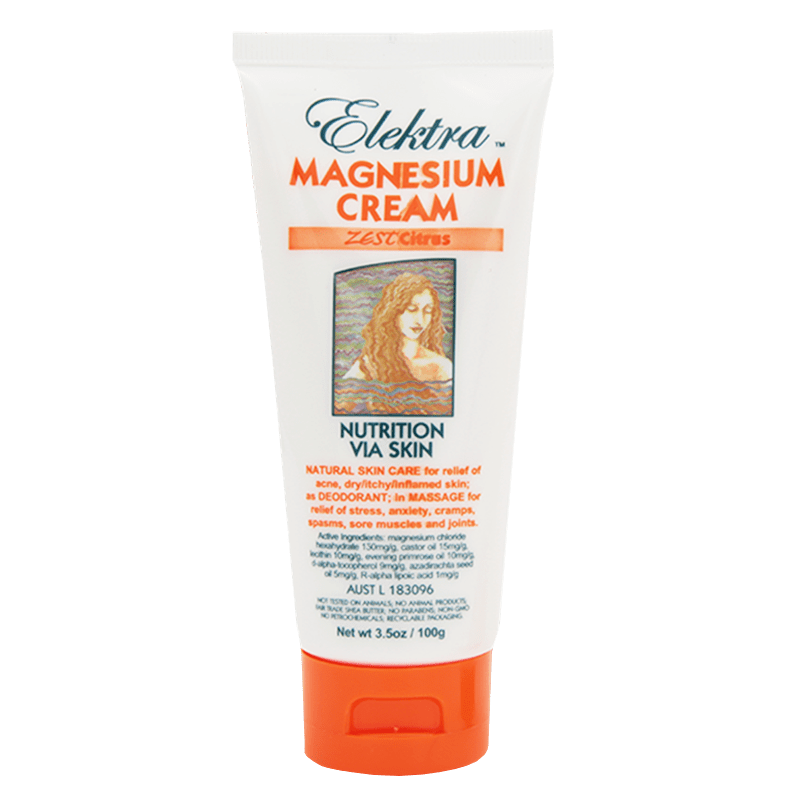I have compiled the most comprehensive list of types of magnesium just for you. And why did I do this? Well… Did you know we need magnesium for over 300 biochemical pathways in our body? That’s right, over 300 functions of our body will not work without sufficient levels of magnesium.
Signs you may be deficient in Magnesium:
😴 Tiredness and low energy
🦵🏼 Muscle cramps and spasms
💩 Constipation
☀️ Low vitamin D levels
😨 Stress, worry and anxiety
🤕 Headache and migraine
⚡️ Back and neck pain
😳 Trouble getting to sleep
There are also more serious health problems that have also been linked to magnesium deficiency such as:
🦴 Osteoporosis
💔 Cardiovascular disease
💉 Type II diabetes

What is the recommended dosage and how much is too much?
Firstly, I would like to say that it is very difficult to overdose on magnesium. I often suggest magnesium to pregnant women (pregnancy cramps and restless legs are the worst!) and they are often quite concerned whether magnesium is safe during pregnancy and if their pre-natal contains magnesium, will that be too much? Definitely not! According to one source, “Magnesium is relatively safe to apply because toxicity may not occur before oral intake of 30 g magnesium sulfate.” 30g is 30,000mg, which is 5 to 10 times the dose we tend to recommend (300-600mg a day). But the amount required depends on a lot of factors; diet, stress, sleep, exercise and other chemical or drug exposures. But different types of magnesium have different absorption and therefore different effects on the body.
The most frequent negative side-effect of magnesium is diarrhoea. This tolerance level doesn’t just change depending on how much magnesium your body needs, but also how much your digestive system is able to tolerate. Reducing your oral dosage of magnesium to bowel tolerance is a good start, you can then use other forms of magnesium to increase your total dosage. Transdermal magnesium, used as an oil or a cream, is a great way to get more magnesium into your system. Elektra Magnesium is my favourite as they have different strengths depending on your needs. They also have a new baby strength ‘Calm Balm’.

What exactly does Magnesium do?
Healthy Muscles
Magnesium helps with the contraction and relaxation of muscles, this is a requirement for smooth movement of muscles and joints. Cramps and spasms occur when this normal function is disrupted in some way. It can also present as stiffness, tightness and tension. This symptom can occur during exercise or movement, in a resting state or even while sleeping. After exercise or other hard work, magnesium helps to restore normal electrolyte balance and helps muscles to recover more quickly. There are certain types of magnesium that are better for muscles relaxation.
Nervous System Function
The average human brain contains about 86 billion nerve cells. These nerve cells called neutrons are constantly sending messages to and from the body. There are literally millions of messages telling the brain where the body is and the brain telling the body what to do, also our thoughts, awareness planning and feeling emotions. This conduction of messages through the nervous system requires adequate amounts of magnesium to function smoothly and optimally. The function of the nerves where they join the muscles (neuromuscular junction) is also where magnesium helps to control the muscles avoiding situations like cramping.
Stress and Anxiety Relief
Due to magnesium’s relaxant properties, it can help to relax the body and mind. It is also a very important mineral for the biochemical pathways associated with stress hormones. So it works in two ways: helping to body stay relaxed and out of stress mode and also as an essential nutrient when the body is ‘wound up’.
Energy Production
Each of our cells needs energy to function, so that our body as a whole can function. Along with a number of vitamins, magnesium has large role to play in creating energy for our cells.
PMS Symtoms
Magnesium can help Pre-menstrual syndrome symptoms in a number of ways. It is involved in hormone pathways, helping to keep our hormones balanced. It relaxes muscles including the muscles that are in the uterus, which can help to relieve period pain and cramping. As magnesium helps to keep stress levels under control it can also help with moods and emotional reactions that can occur with hormone changes. As well as taking a magnesium supplement, taking time out and honouring the body’s processes can go a long way in relieving PMS.
Sleep
Melatonin, a hormone that helps us get to sleep, requires magnesium for its production. So as well as relaxing muscles and relieving anxiety, magnesium can help our body help itself get off to sleep. As magnesium helps to reduce cramping and tight muscles, it can also help us have a deeper, longer sleep reducing wake ups from pain or tension in the body.
Bone Health
Calcium and vitamin D are most often associated with bone health but magnesium should also be included in that list. Magnesium and calcium are closely associated as one can help to regulate the other in bones and muscles. A large amount of magnesium is found within bones. Vitamin D production in the body, the best source of which is the sun, cannot occur adequately without sufficient magnesium.
What are the best magnesium sources?
🥦 Vegetables such as broccoli, cabbage, beans and asparagus and also leafy greens such as kale and spinach.
🍌 Fruits such as banana and avocado
🌰 Nuts and seeds, particularly pumpkin, flax and chia seeds or almonds, brazil nuts and cashews
🟢 Legumes such as lentils, beans, chickpeas and green peas.

However, due to depleted soils, agricultural practices and the fact we just don’t eat enough unprocessed, real foods, it is very difficult to get the amount of magnesium we need from just our diet. Remember there are over 300 different functions of your body relying on this one nutrient. Supplementation even just in the short time is the best way to get your levels back to optimum.
But where to start?
There are SO many different types of magnesium out there and to be honest, some are pretty bad. I won’t give any suggestions on brands, but here is my comprehensive list of types of magnesium so you can make your choice. The difference with all of these is what the magnesium is bound to and what they compound also does in your body.
The Most Comprehensive List of Types of Magnesium
Magnesium Citrate
One of the most easily absorbed forms of magnesium. It is a magnesium bound to citric acid. It can have a laxative effect, so this one is great if you’re taking magnesium for constipation. If you ever did human biology, you may remember the Citric Acid cycle related to energy production in the body. No? Ok. Well, magnesium citrate feeds into that cycle, so this one is also great for providing energy.
Used for: Increasing energy and bowel movements
Avoid if: You’re prone to tummy upsets
Magnesium Glycinate
Glycine is a neurotransmitter (brain chemical) that helps with relaxing your nervous system. This type of magnesium is bound to glycine so it is a great form for inducing a calm mind which helps with relaxation, anxiety and a good sleep. It’s less likely to have a laxative effect.
Used for: Keeping you calm if you have trouble sleeping or are prone to anxiety
Avoid if: No reason, unless there is a better option suited to you.
Magnesium Oxide
This is one of the least absorbed forms, but also one of the cheapest forms, so you will find this in cheap supplements and multivitamins. Absorption has been found to be down to about 4%. Not one I’d recommend.
Used for: Cheap source
Avoid if: You can afford a better option
Magnesium L-Threonate
As the only form of magnesium that crosses the blood brain barrier, magnesium L-threonate is one of the best forms for cognitive, mood and stress related issues. It was shown in one Janapaese study to reduce development of dementia by 37% in people over 60 years.
Used for: Chronic pain, stress, memory and anything else brain related
Avoid if: No reason, unless there is a better option suited to you.
Magnesium Malate
Combined with malic acid, a natural fruit acid, magnesium malate is more gentle on the digestive system that oxide or citrate. As malic acid is also involved in energy production, this form is also good for anyone suffering from fatigue and also conditions such as fibromyalgia.
Used for: Increasing energy, muscle fatigue or pain
Avoid if: No reason, unless there is a better option suited to you.
Magnesium Chloride
Often found as bath salts, magnesium chloride can also be taken as a liquid. The chloride part is the same molecule that makes up our stomach acid, hydrochloric acid. Stomach acid is known to decline with age, despite many people prescribed medication to stop acid production. Magnesium chloride can enhance its own absorption in people with low stomach acid levels.
Used for: As a bath salt for sore muscles and relaxation
Avoid if: No reason, unless there is a better option suited to you.
Magnesium Sulfate/Sulphate
Also known as Epsom Salts, this form of magnesium is also usually associated with bath salts. It can also be taken orally but can have a laxative and detoxing effect due to the sulphur present. Compared with Magnesium Chloride as a bath salt, Epsom salts can be very drying to the skin, but it is a cheaper form that chloride.
Used for: Cheap form for a relaxing bath
Avoid if: You’re prone to dry skin
Magnesium Amino Acid Chelate
Minerals are often bound to amino acids to aid in the absorption. This type of magnesium is high bioavailable and can correct a deficiency quickly.
Used for: Increasing your levels quickly
Avoid if: No reason, unless there is a better option suited to you.
Magnesium Taurate
Another form combined with an amino acid, this time taurine. Taurine is known for it’s benefits on heart health, so this is the one if you’re taking magnesium to aid your cardiovascular system. One study also found that this form helped to prevent or slow the onset of cataracts.
Used for: Heart health
Avoid if: No reason, unless there is a better option suited to you.
Magnesium Oil
This is a topical form of magnesium chloride. It can come as a spray or a rub. It may sting when first applied, but manufacturers say that that is a sign it’s being absorbed.
Used for: Topical application of magnesium for extra supplementation or to apply directly to muscles. Also great for those who can’t ‘stomach’ oral supplements
Avoid if: Using with children, their skin might be too sensitive to the sting
If you are looking for a food based source of magnesium, check out my Nutrient Smoothie Series for a high magnesium smoothie to start your day – Nutrient Dense Smoothie Series


Pingback: Magnesium Boosting Smoothie - Santosha Health & Wellbeing Centre